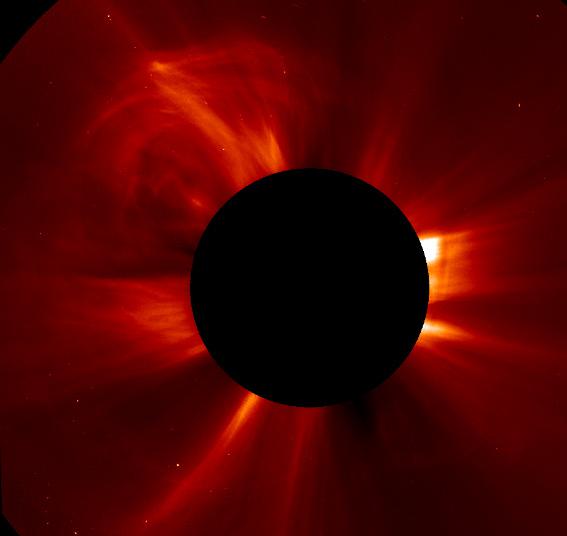The Sun’s been quiet lately, which is weird. We should be heading for the peak of its 11 year magnetic cycle, when it should erupt pretty often with sunspots, solar flares, and gigantic storms called coronal mass ejections (CME).
But it’s been holding its tongue the past few weeks. There have been sunspots, but not many, and none very big. There have been surprisingly few eruptive events, too.
That changed yesterday morning:
On Mar. 15, around 06:00 UTC (02:00 Eastern U.S. time) the Sun blew out a decent-sized CME, and it’s headed toward Earth. This isn’t a very big one, so the effects will probably be moderate at best, but it could produce some aurorae if you live at a high latitude (farther north than about 45°, and farther south than -45°). It could hit as early as tonight.
In the video, made using data from the NASA/ESA SOHO satellite, the Sun is blocked by a metal disk to allow fainter material to be seen. Both Venus and Mars are in the frame, and you can see stars moving in the background as well.
There’s nothing to fear here, I’ll add. You won’t turn into the Hulk, and this won’t spark a global apocalypse. In general these happen all the time. This one’s noteworthy because it’s the first in a while.
You can also see it in this wonderful time-lapse video taken using the Sun-observing STEREO-B spacecraft, currently over 250 million kilometers away. From its viewpoint it can see the Sun (off the frame to the left), the Earth (far right), Mercury (left), and the incredible comet Pan-STARRS (which is obvious enough). The CME erupts right at the end (I have a longer description of this spacecraft and the comet in a previous post).
In the video it looks like the CME will hit the comet, but it may not. You’re seeing objects at very different distances here, all compressed in the third dimension. From STEREO-B’s perspective, the comet is in the foreground, tens of millions of kilometers closer than Earth is. The CME at the end is headed toward us, and may miss the comet entirely.
It’s interesting that the Sun has been quiet lately. Things were ramping up pretty well there for a while, then it petered out. I noticed this a couple of months ago while doing some research for a blog post, and I’ve had folks email me about it. Here’s a graph from the Space Weather Prediction Center showing sunspot number over time, which is a pretty good indicator of solar activity:

Image credit: Space Weather Prediction Center
The black dots are the number of visible sunspots; the blue line a monthly average, and the red line the predicted future number. As you can see, we hit the solar minimum in 2008-2009, and it started heading back up in late 2010. We should be nearing or at the peak now, but for some reason the sunspot number stalled in late 2012. There was a huge peak in late 2011, then a huge drop in early 2012, so clearly the Sun is undergoing some sort of magnetic hiccupping. We may still see a big jump later this year, or it may simply slack off from here. The magnetic field of the Sun is fiercely complex and extremely difficult to understand.
The minimum in 2009 lasted nearly two years, far more than usual, so everyone expected this peak to be a little weird, too. Ironically, it’s living up to our expectations by behaving unexpectedly. As usual, we’ll just have to wait and see what it does.
Tip o’ the occulting disk to Alice Enevoldsen and SungrazerComets on Twitter.
